HUNGARIAN
GLIDERS
1933-2000
| Type designation: |
Szent György I and II |
| Name: |
Szent György I and II |
| Designer: |
Sándor SVACHULAY |
| Class: |
Gyakorló |
| General arrangement: |
Shoulder wing with gull form, closed fuselage, open cockpit |
| Crew: |
1 |
| First flight: |
Szen György I: 1933 Spring; Szent György II 1933 September 3 |
| Manufacturer: |
Workshop of Sándor Svachulay |
| Number of built: |
1-1 |
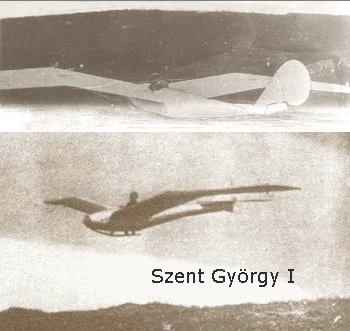
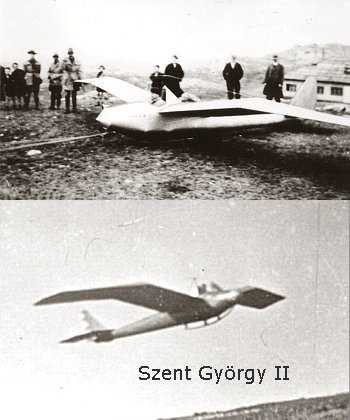
Short history:
After Bleriot had flown demonstration flights in Budapest in 1909, the first aeroplanes designed and built in Hungary appeared around 1910. One of the first successful designer was Sándor Svachulay, who had started his experiments with different flying models in the last decade of the 19th century. He experimented with flapping-wing models as well and to understand flight he had studied birds flying with steady spread wings. One of the results of these early studies were two small glider designed and built in the early '30s. His goal was to build the smallest glider, which is capable of carrying one person.
The first glider got the name of Szent György (Saint George) but on the glider field she was simply called Gyuri (Georgie). This glider originally got no rudder but before the first flight it was modified to have one. After the first flights in the Spring of 1933, it was common opinion that the glider is not sound structurally. Svachulay built a new glider whithin six weeks with smaller span and with modified wing bracing, which got the name of Szent György II. A static test were carried out to evaluate the strength of the structure. This version first flew at September 3, 1933.
Both gliders - mostly the second version - were used for one and a half year. The longest flight was of 52 minutes. Because of the light structure of both gliders, finally they were officially grounded. The first version never flew again. The designer donated the Szent György II to two students - both of them glider pilots - of the Technical University, who tried to reinforce the structure. The modified glider was crashed and destroyed at September, 1935.
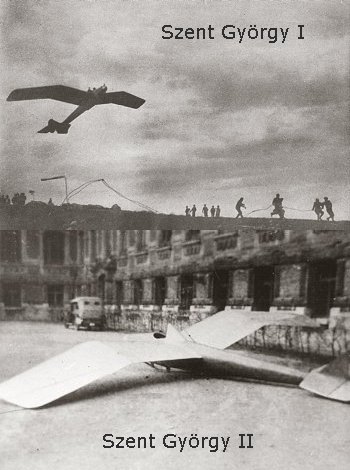
Structure: All wooden
Wing:
The center part of the wing had rectangle form and had a positive dihedral angle. The outer panels had a constant chord as well, but were swept backward and had a negative dihedral angle. Four spars were used and the narrow surface in front of the fore spar were covered by plywood. The other parts of the wing as well as the ailerons were fabric covered. The wing were wire braced on both versions. At the first version one wire run over the cockpit directly between two points on top of the wing where the dihedral angles changed. Two wires connected points under the wings and run paralelly under the fuselage. The second version had a different bracing. The upper brace-wire conneted the points on the top of the wing to a steel tube stand on top of the fuselage just behind the cockpit.
Fuselage:
The fuselage constructed of parts having circle cross sections. It was covered by plywood. The open cockpit was placed between the wings on top of the fuselage. Tha landing gear consisted of a rubber-ring dumped main and a steel plate tail skid.
Tail unit:
The fabric covered tail surfaces were of flat frame structures.
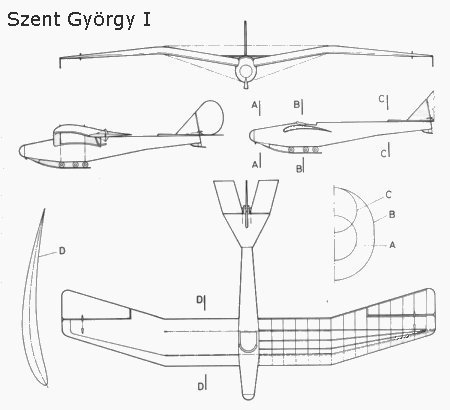
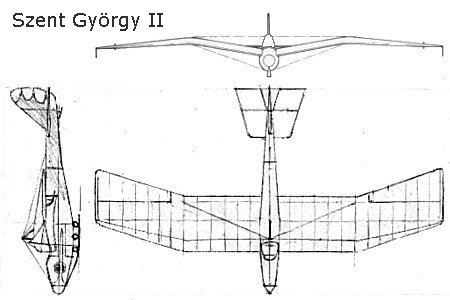
| Dimensions: |
| Wing: |
| Span, m: |
Szent György I: 10,5; Szent György II: 9,6 |
| Area, m2: |
Szent György I: 11 |
| Aspect ratio: |
Szent György I: 10 |
| Chord (root), m: |
Both versions: 1,5 |
| Airfoil (root), m: |
Camber: 9,5%; Thickness: 9% |
| Dihedral, degree: |
Center: 10; Outer: -2,5 |
| Sweep, degree: |
Center: 0; Outer: cca. 20 |
| Washout: |
? |
| Aileron: |
| Span, m: |
? |
| Mean chord, m: |
? |
| Total area, m2: |
cca. 1,8 |
| Balancing: |
? |
| Horizontal stabilizer: |
| Span, m: |
? |
| Area, m2: |
? |
| Elevator: |
| Span, m: |
? |
| Area, m2: |
? |
| Airfoil: |
Flat |
| Balancing: |
? |
| Trim: |
? |
| Vertical stabilizer and rudder: |
| Total area, m2: |
? |
| Rudder area, m2: |
? |
| Balancing: |
? |
| Fuselage: |
| Length, m: |
? |
| Width, m: |
? |
| Height: |
? |
| Cross section, m2: |
? |
| Landing gear: |
| Type: |
Skid, rubber dumped |
| Masses: |
| Wing, kg: |
? |
| Fuselage, kg: |
? |
| Tail unit, kg: |
? |
| Empty glider, kg: |
Szent György I: 60 |
| Gross, kg: |
Szent György I: cca. 135 |
| Wing loading, kg/m2: |
Szent György I: cca. 12 |
| Speeds: |
| VNE, km/h: |
? |
| Max. speed in rough air, km/h: |
? |
| Stall speed, km/h: |
? |
| Performance: |
| Min. sink, m/s (at gliding speed, km/h): |
?/? |
| Best L/D (at gliding speed, km/h): |
?/? |
| Start methods: |
Bungee |

Origin of data and 3-view drawing:
Jereb Gábor: Magyar vitorlázó repülőgépek, Műszaki Könyvkiadó, 1988, Budapest
(Gábor JEREB: Hungarian Gliders, Technical Publishing House, 1988, Budapest)
Gábor FEKECS E-mail: fekecs.gabor@t-online.hu




